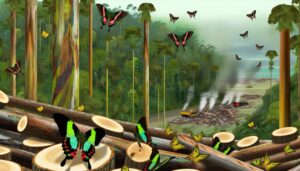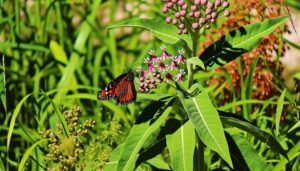Tracking the Queen Butterfly’s Long Journey: From First Instar to Adult
The complete metamorphosis of a Queen butterfly from the first instar stage to an adult butterfly typically spans 30 to 40 days. This period begins with the caterpillar hatching and proceeding through five instar stages, where rapid growth and molting occur.
Upon reaching the final instar, the caterpillar prepares for pupation by forming a chrysalis, where extensive internal reorganization transforms it into an adult butterfly. Environmental conditions, such as temperature and humidity, greatly influence the duration of these stages, affecting the overall lifecycle.
For thorough insights into each stage, further exploration will provide more detailed understanding.

Key Takeaways
- The egg stage begins with oviposition on host plants, typically milkweed.
- The larval stage, including five instar stages, lasts around 2 to 3 weeks.
- Pupation, forming a chrysalis, lasts approximately 10 to 14 days.
- The entire life cycle from egg to adult butterfly spans about 4 to 5 weeks.
Life Cycle Overview

Understanding the life cycle of a Queen Butterfly (Danaus gilippus) involves examining the distinct stages of development from egg to adult, each characterized by its unique physiological and behavioral changes.
The process begins with oviposition, where eggs are laid singly on host plants. These eggs hatch into larvae, which undergo five instar stages, each marked by molting and significant growth.
Following the larval stage, the caterpillar forms a chrysalis, entering the pupal stage, during which metamorphosis occurs. This transformative phase culminates in the emergence of an adult butterfly.
Each stage of development plays a critical role in the butterfly's life cycle, with specific environmental and biological factors influencing the duration and success of each phase.
The First Instar Stage
The first instar stage of the Queen Butterfly begins immediately after the egg hatches, revealing a small, translucent caterpillar equipped with functional mandibles for feeding.
During this stage, the caterpillar's primary activities are:
- Feeding on Milkweed: Essential for acquiring chemical compounds that provide toxicity as a defense mechanism.
- Rapid Growth: The caterpillar increases its body mass considerably, driven by its constant consumption of milkweed.
- Molting: The caterpillar sheds its exoskeleton to accommodate its increasing size, moving to the next instar stage.
This initial period is critical for the caterpillar's survival, as adequate nutrition and growth set the foundation for successful subsequent stages.
The intricate combination of feeding, growth, and molting underscores the importance of the first instar in the Queen Butterfly's development.
Transition to Pupa

As the Queen Butterfly caterpillar completes its final instar stage, it undergoes a dramatic transformation, preparing to enter the pupal phase where it will metamorphose into an adult butterfly.
During this critical change, the caterpillar ceases feeding and searches for a suitable pupation site. It then attaches itself to a secure substrate using a silk pad and a cremaster—a small hook-like structure.
Once anchored, the caterpillar molts for the last time, revealing the chrysalis beneath its skin. This chrysalis, initially soft and vulnerable, soon hardens to form a protective casing.
The transformation within is profound, as larval tissues reorganize into the complex structures of an adult butterfly, setting the stage for the upcoming chrysalis phase.
The Chrysalis Phase
Upon completion of the final molt, the Queen Butterfly caterpillar enters the chrysalis phase, during which it undergoes extensive reorganization of its internal and external structures.
The pupal stage is a period of profound transformation, characterized by the breakdown of larval tissues and the formation of adult features. This metamorphosis, mediated by hormonal changes, typically spans 10 to 14 days.
During the chrysalis phase:
- Proteins and Enzymes: Enzymes break down caterpillar tissues into a nutrient-rich “soup,” providing raw materials for new structures.
- Imaginal Discs: Clusters of cells known as imaginal discs develop into wings, antennae, and other adult body parts.
- Chrysalis Coloration: The chrysalis often exhibits varying shades of green and gold, which serve as camouflage.
This phase is critical for successful maturation into an adult butterfly.
Emerging as a Butterfly

Emerging from the chrysalis, the newly formed Queen Butterfly marks its change to adulthood by carefully expanding and drying its wings. This vital process, known as eclosion, involves the butterfly hanging upside down to allow hemolymph to fill the wing veins, thereby expanding them to their full size. As the wings harden, the Queen Butterfly prepares for its first flight, ensuring they are fully functional for survival. This striking species, often mistaken for the Monarch, derives its queen butterfly name origin from its regal coloration and resemblance to the Monarch’s royal namesake. Once ready, it embarks on a journey to find nectar-rich flowers and suitable mates, continuing the life cycle.
The butterfly will remain in this position for several hours, ensuring that its wings dry and harden properly. Proper wing expansion is essential for flight capability and overall survival. During this time, the butterfly's exoskeleton also hardens, providing necessary protection.
Once the wings are fully expanded and dried, the Queen Butterfly is prepared to take its maiden flight, marking the final stage in its metamorphosis from larva to adult.
Conclusion
The extensive life cycle of the Queen butterfly, from the first instar stage to its emergence as an adult, unfolds over approximately 30 to 40 days, contingent upon environmental conditions.
Curiously, during the chrysalis phase, the transformation is so profound that the caterpillar's internal structures are entirely reorganized.
This intricate metamorphosis highlights the complexity of lepidopteran development and underscores the delicate balance within ecosystems that supports such biological marvels.






